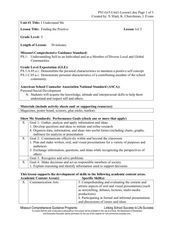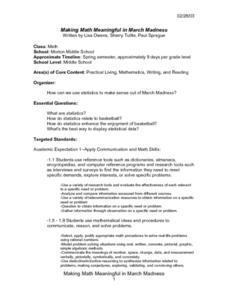Curated OER
Pinckney Benedict's "The Sutton Pie Safe" from Town Smokes
Students read Pinckney Benedict's "The Sutton Pie Safe" to learn about family symbols and social commentary. For this close reading lesson, students read four journal prompts for the story and answer the listed questions for each section.
Curated OER
History and Geography: Making a New Nation
Fifth graders examine the contributions of the different groups that built the American Nation. They identify the successive waves of new immigration, explain their attraction to America, and study the importance of Ellis Island.
Curated OER
Tracking Down Meaning in Great Expectations
Fourth graders are assigned an unique theme, symbol, or character in Great Expectations. They becomes the class expert on that facet of the novel while learning the basic skills needed to write a research paper.
Curated OER
Earth's History
Sixth graders investigate how fossils are formed. They analyze a photo of the Grand Canyon, and create a fossil cast and mold using plaster of paris and shells.
Curated OER
ECONOMIC SYSTEMS
Students list and explain the three types of economic systems as well as the three economic questions that every economic society must answer at one time or another. In addition, they identify the five features of our market economy.
Curated OER
Economic Decisions
Students practice decision-making skills by planning vacation, including all proposed expenses. Students distinguish between needs and wants, identify difference between goods and services, and describe economic resources used in...
Curated OER
ESL Autobiographies
Pupils develop collaborative skills while creating a vocabulary word list. They work together to take each others photos using a digital camera. Students access a website to copy and paste their photos into a word document. They create...
Curated OER
The Microscope
Students investigate the parts and functions of a compound microscope. They explore various websites, label the parts of a microscope on a worksheet, view prepared slides, and create drawings of the prepared slides.
Curated OER
Matter & Subatomic Particles
Seventh graders divide into small groups to construct several models. Each group builds with an accompanying chart showing the colors of gumdrops used for the protons, electrons, and neutrons.)
Curated OER
Fraction Equivalence
Fourth graders explore fractions. They compare different fractions using fraction bars. Students find equivalent fractions and they use fraction bars to visualize addition of fractions.
Curated OER
Arts & Entertainment/Production Marketing
High schoolers demonstrate a comprehension and a tasteful appreciation of the creative and performing arts. They seek, experiments, and shares reactions of different forms of art. Students analyze and reflect on others' work. They...
Curated OER
Finding the Positive
Fifth graders meet the "Famous Artist." They are introduced to the topic of self-concept. Students work in small groups and get organized to create collages. They create a collage that represents characteristics of positive self-concept.
Curated OER
Finding the Friendship Dolls, A True Story: How Children Can Create World Peace
Students listen to the book Finding the Friendship Dolls, A True Story: How Children Can Help Create World Peace through Toys. In this world peace lesson, students choose events in the story to create a timeline of those events. Students...
Curated OER
Metis - Grade 10
Tenth graders investigate the organization and purpose of the Metis. In this Canadian history lesson, 10th graders watch "Metis Settlements," and then participate in talking circles sharing their impressions of the video.
Curated OER
Parts of Speech: Nouns
Second graders discuss nouns. In this language arts lesson plan, 2nd graders discuss nouns and pronouns. Students identify various types of nouns on a worksheet. Students play "Popcorn" Nouns.
Curated OER
The Fat and the Lean
Students collect data on calorie intake. In this algebra lesson plan, students use the collection of data to make better eating decisions. They investigate the nutritional value in food using a graph and draw conclusion from their findings.
Curated OER
GMOs: Should We Grow Them?
Students examine the ethics of biotechnology and genetically modifying various organisms. They complete various activities and labs on GMOs and then write a position paper regarding their individual opinions on the subject.
Curated OER
Making Math Meaningful in March Madness
Middle schoolers examine the statistics of March Madness, the college basketball tournament. They watch videotaped basketball games to collect data for further analysis using Word and Excel. They analyze the data in a variety of...
Curated OER
World Fair? A Global Classroom Unit On Economic Rights
Students explore economic rights of people. After listening to statements and songs by people such as John Lennon and Mahatma Ghandi, students examine the truths and values depicted by each person. Students participate in a simulation to...
Curated OER
Chinese, Japanese, and Korean Language Basics
Students in seventh and eighth grade Introduction to Foreign Language class are introduced the basic greetings, farewells, courtesy words, and basic phrases in Mandarin Chinese, Japanese and Korean. In pairs, they create a very short...
Curated OER
Those Cells Look Good Enough to Eat
Students explore the parts of the cell. In this cell lesson, students use foods to create cell models that represent the nucleus, cytoplasm, cell membrane, mitochondria, ribosomes, vacuoles, endoplasmic reticulum, and Golgi bodies...
Curated OER
Cannonball
Students calculate the speed, motion and distance of a projectile. In this geometry lesson, students obtain measurements while calculating velocity. They graph their results and make predictions.
Curated OER
Digging Up Facts About Dinosaurs
Second graders conduct research on a given dinosaur using various resources, complete an information sheet that be used to create their graphic organizer from, and produce a graphic organizer, using the Kidspiration software.
Curated OER
Ancient Refuge in the Holy Land - International Phonetic Alphabet
Young scholars research the uses and symbols of the International Phonetic Alphabet. They complete a worksheet to translate and transcribe phrases of English into the International Phonetic Alphabet.

























